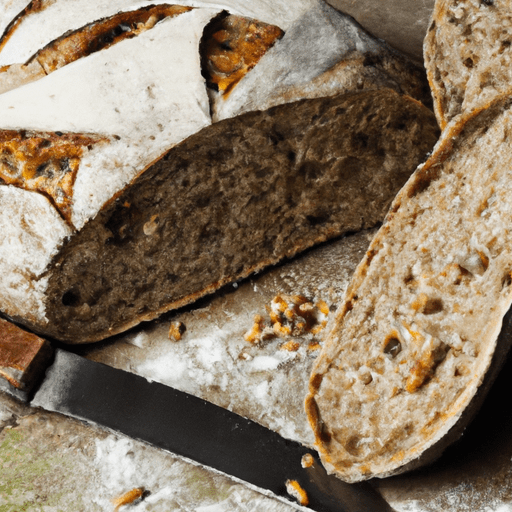The Beauty of Gluten-Free Bread: A Delicious and Nutritious Alternative
Bread is a beloved staple in many diets, but for those who follow a gluten-free lifestyle, satisfying that bread craving can be a challenge. Luckily, the world of culinary creativity has brought us gluten-free bread, a delectable alternative that allows everyone to enjoy the simple pleasure of a warm, freshly baked loaf. In this blog post, we’ll delve into the world of gluten-free bread, exploring its taste, common uses in cooking, nutritional value, and even uncovering some interesting history and facts.
The Taste of Gluten-Free Bread: Delightful and Versatile
When it comes to taste, gluten-free bread has come a long way in recent years. Gone are the days of dry, cardboard-like loaves that crumble at the slightest touch. Today, bakers and food manufacturers have developed mouthwatering gluten-free bread recipes that can rival their gluten-laden counterparts.
Gluten-free bread is often made from a combination of alternative flours, such as rice flour, almond flour, tapioca flour, or sorghum flour. These flours, when skillfully combined, create a bread that is moist, tender, and full of flavor. The taste can vary depending on the recipe and ingredients used, but it’s safe to say that gluten-free bread can be enjoyed by all, regardless of dietary restrictions.
Versatility in the Kitchen: Beyond Sandwiches
Gluten-free bread is not just limited to sandwiches. It can be used in a variety of creative ways in the kitchen. From hearty breakfast toasts to delectable bread pudding desserts, the possibilities are endless.
One popular use for gluten-free bread is in French toast. The bread’s slightly denser texture absorbs the custard beautifully, resulting in a delightful breakfast treat. Toasted gluten-free bread can also be used as a base for open-faced sandwiches or topped with avocado, poached eggs, and a sprinkle of sea salt for a delicious and nutritious meal.
Nutritional Value: Wholesome and Nourishing
Gluten-free bread can be a nutritious addition to your diet. While it may not have the same high fiber content as whole wheat bread, it can be a great source of essential nutrients when made with the right ingredients.
Many gluten-free bread recipes incorporate ingredients like flax seeds, chia seeds, or psyllium husk to boost the fiber content. These add-ins not only increase the nutritional value but also contribute to the overall texture and taste of the bread.
Additionally, gluten-free bread is often fortified with vitamins and minerals to ensure it meets dietary needs. It’s important to read labels and choose brands that focus on using wholesome, nutrient-dense ingredients.
A Brief History of Gluten-Free Bread
The demand for gluten-free products, including bread, has grown exponentially in recent years. However, the concept of gluten-free baking is not entirely new. In fact, ancient civilizations like the Egyptians and Romans experimented with gluten-free flours made from rice or legumes.
The modern gluten-free movement gained momentum in the mid-20th century when researchers and physicians began studying celiac disease and gluten intolerance. This led to the development of gluten-free bread recipes and a greater understanding of the dietary needs of those with gluten-related disorders.
Fun Facts about Gluten-Free Bread
- Some gluten-free bread recipes utilize unique ingredients like mashed bananas or apple cider vinegar to enhance the taste and texture of the final product.
- In addition to gluten sensitivity or celiac disease, some people choose gluten-free bread as part of a balanced diet due to its potential benefits for digestive health and reducing inflammation.
- Gluten-free bread can be made at home using a bread machine or traditional oven. Many gluten-free baking enthusiasts enjoy experimenting with different flour combinations and add-ins to create their perfect loaf.
Gluten-free bread may have started as a necessity for a specific group of individuals, but it has quickly become a delicious and nutritious option for anyone seeking a diverse and inclusive culinary experience. So, whether you refrain from gluten or simply want to explore new flavors, give gluten-free bread a try and discover the joy of breaking bread without compromise.
Origin:
Gluten-free bread is a type of bread that is made without the protein known as gluten. Gluten is naturally found in certain grains such as wheat, barley, and rye. The concept of gluten-free bread emerged as a response to the dietary needs of individuals with celiac disease or gluten sensitivity.
Common Uses:
Gluten-free bread is primarily used as a substitute for traditional bread for those with gluten-related dietary restrictions. It can be used to make sandwiches, toast, French toast, or served alongside meals. It is also used as an ingredient in various gluten-free recipes such as breadcrumbs, croutons, and stuffing.
Nutritional Benefits:
Gluten-free bread is often fortified with added vitamins and minerals to compensate for the lack of nutrients in alternative grains used to make the bread. It can be a source of essential nutrients like fiber, iron, and various B vitamins. However, the nutritional benefits can vary depending on the specific ingredients used in the bread.
Unique Properties or Historical Significance:
Gluten-free bread typically has a different texture compared to traditional bread due to the absence of gluten. It can be denser, crumblier, or have a shorter shelf life. Many gluten-free bread recipes use a combination of alternative flours, such as rice flour, potato flour, tapioca flour, or cornmeal, to achieve a palatable texture and flavor.
The market and availability of gluten-free bread have significantly expanded in recent years, reflecting the growing demand for gluten-free products. However, the concept of gluten-free diets is not new and has been practiced by people with gluten-related health conditions for centuries. Historically, gluten-free grains like rice, corn, and millet were used in various cultures as alternatives to gluten-containing grains.




Use the share button below if you liked it.
It makes me smile, when I see it.